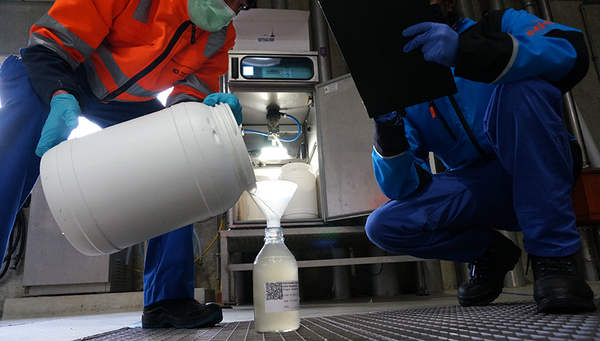Archive detail
Coronavirus wastewater monitoring expanded in Switzerland
March 9, 2021 |
Media information from the Federal Office of Public Health FOPH, 9 March, 2 pm, Live broadcast on Youtube (in German / French)
Since the summer of 2020, wastewater samples have regularly been collected at wastewater treatment plants (WWTPs) in Zurich and Lausanne and tested for the novel coronavirus – with analyses now being carried out daily. The research project was jointly launched by Eawag and EPFL, and ETH Zurich is now also participating, to enable the sequencing of viral genetic material from individual samples, so that variants can also be detected. This project has now been expanded: from February to July 2021, wastewater samples are being collected from another four WWTPs – in Altenrhein, Chur, Laupen and Lugano. The plants were selected on the basis of their geographical location and the structure of the catchment area. To gather as much experience as possible, largely rural as well as urban regions are to be studied. The project was presented today by Eawag environmental engineer Christoph Ort at the Federal Office of Public Health’s regular COVID-19 press conference. We asked Christoph Ort to answer four questions.
What are the advantages of looking for the virus in wastewater?
Christoph Ort: First of all, the results don’t depend on whether or how many clinical tests are performed, since everyone goes to the toilet – including coronavirus sceptics. Although wastewater doesn’t lie, we need to develop sophisticated methods of measurement and data analysis to get the true story. And secondly, with this approach, a single wastewater sample, collected over a period of 24 hours from the inlet of a large treatment plant, will cover a large number of people – around 450,000 in the case of the Zurich Werdhölzli plant.
What can wastewater analysis not do?
Measurements of virus concentrations can track the curve of infections, but they only provide limited information on the actual number of cases. That’s because we still don’t know enough about who excretes how much identifiable viral genetic material, and when this occurs. Initially, we had also hoped that wastewater analysis would provide information much more rapidly than clinical tests. Researchers in Switzerland and abroad were talking about up to two weeks’ early-warning time. Since a lot more testing can now be done, and the results are available sooner than they were at first, we’re no longer so far ahead.
Several research groups around the world have been working on methods of detecting the coronavirus in wastewater. Why can’t you simply agree on a single method?
That could be possible, at a later date. In the case of wastewater testing for drug consumption, we’ve now developed pan-European standards, and we use ring tests to make sure all the labs involved are measuring in the same way. But that took almost 15 years! However, when something new appears, it’s precisely competition among scientists that means various techniques and scenarios are studied, thus helping to deal with the problem more rapidly than if everything was first standardised. There would then be a substantial risk of backing the wrong horse, and specific local conditions – for example, concerning the composition of wastewater – would not be taken into consideration.
When can we expect to see wastewater monitoring covering the whole of Switzerland?
It’s not a research institute’s responsibility to develop a routine monitoring programme. But we are already making our expertise available – for the federal or cantonal authorities, or also for private laboratories. From my point of view, a basic wastewater monitoring programme would be particularly valuable once the virus appears to have been suppressed and clinical testing is no longer being widely performed. Then, positive results from wastewater would have the early-warning function I mentioned. The expansion now underway will give us additional knowledge and experience that will be useful if monitoring is applied on an even wider scale.
Cover picture: Eawag, Andri Bryner


